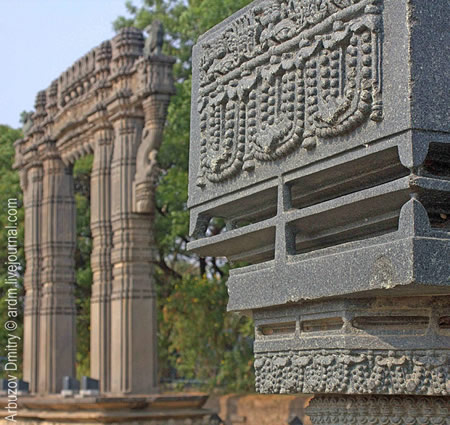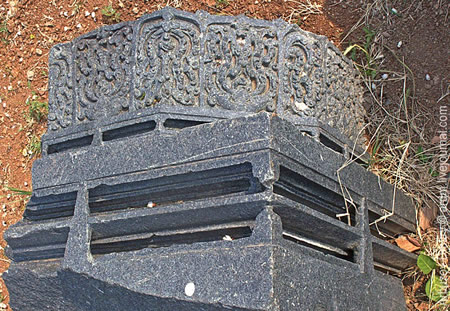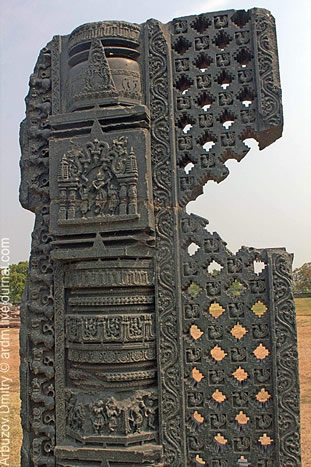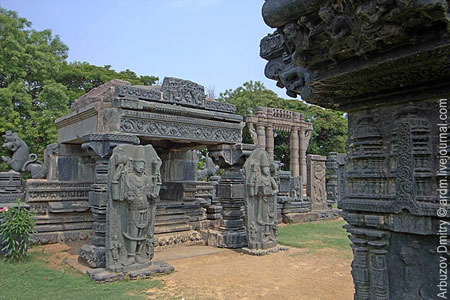Warangal Fort
Warangal Fort, in Warangal in the Indian state of Telangana, appears to have existed since at least the 12th century when it was the capital of the Kakatiya dynasty. The fort has four ornamental gates, known as Kakatiya Kala Thoranam, that originally formed the entrances to a now ruined great Shiva temple. The Kakatiyan arch has been adopted and officially incorporated into the Emblem of Telangana after the state bifurcation.
History
 Initially, Warangal was under the rule of the Yadava kings in the 8th century; in the 12th century, it came under the control of the Kakatiya dynasty. Although precise dating of its construction and subsequent enhancements is uncertain, historians and archaeologists generally agree that an earlier brick-walled structure was replaced with stone by Ganapatideva, who died in 1262, and that he was succeeded by his daughter Rudrama Devi, who ruled until 1289, and then her grandson Prataparudra II, whose reign came to be known as a "Golden Age". Twenty years later his kingdom was conquered by the Sultans of Delhi.
Initially, Warangal was under the rule of the Yadava kings in the 8th century; in the 12th century, it came under the control of the Kakatiya dynasty. Although precise dating of its construction and subsequent enhancements is uncertain, historians and archaeologists generally agree that an earlier brick-walled structure was replaced with stone by Ganapatideva, who died in 1262, and that he was succeeded by his daughter Rudrama Devi, who ruled until 1289, and then her grandson Prataparudra II, whose reign came to be known as a "Golden Age". Twenty years later his kingdom was conquered by the Sultans of Delhi.
Ganapatideva, Rudramadevi, and Prataparudra II all added to the fort's height, building gateways, square bastions, and additional circular earthen walls. This places the construction towards the end of the Kakatiya period.
In 1309, Malik Kafur, the general of Alauddin Khilji, attacked the fort with a large force of 100,000 men and surrounded it. Prataparudra II and his people secured themselves within the formidable fort and battled bravely for many months with the invading army. As the siege could not be lifted for more than six months, Prataparudra II agreed to a truce with Kafur, as a result of which he gave in reparation all the wealth that he had accumulated. This included the famous Koh-i-Noor diamond. This siege was chronicled by Amir Khusrow, who described how the fortifications consisted of a strong outer hardened mud structure with a deep ditch in front that had to be filled with dirt before the army could surmount it.
The inner fortress was built of stone and surrounded by a moat that the Muslim soldiers swam across. The fort as described by Khusrow corresponds to the two inner circles of fortifications that exist today. When Kafur finally left the fort in March 1310, he carried away the bounty on 2,000 camels. The conditions of forging peace with the Delhi Sultanate included a clause that Pratapa Rudra would pay an annual tribute and that he would bow every day towards Delhi as a tributary king denoting his subordinate status to the Sultan of Delhi. After Kafur's departure, Pratapa Rudra started ruling again, and during this time some of his vassal chieftains had declared themselves independent rulers of their fiefdoms. But in 1311 Pratapa Rudra had to support the Sultan in invading the Pandyan kingdom, which he did, and he also succeeded in getting the vassals back under his control.
Again in 1318, as Pratapa Rudra had willfully ignored paying the annual tribute to the Sultans of Delhi, Warangal Fort was attacked and held in siege. The superior military power (including superior implements to lob stone missiles and many other similar tools) of the Sultan's army again forced Pratapa Rudra to sue for peace. The invaders had even put up a 450 feet (140 m) earthen ramp across the moat which enabled them to breach the stone walls of the fort and capture it. He again paid a huge tribute to the Sultan in the form of a contingent of horses and elephants, which became an annual fee to be paid to the Delhi Sultanate. After he sued for peace, the Sultan bestowed on him a "mace, a decorated robe (qaba) and a parasol". And again he had to bow towards the imperial capital of Delhi as a mark of his vassal status.
 When in 1320 Pratapa Rudra again defaulted on his annual payment to the Delhi sultans, the then ruler of Delhi who had replaced Khilji, Sultan Ghiyath al-Din Tughluq, sent his son Ulugh Khan to recover the dues. For a third and final time, the fort was attacked by Sultan Muhammad bin Tughluq (r.1325–51), who held siege over the fort. Due to internal dissension, Ulugh Khan had to retreat to Devagiri. After a temporary respite, Ulugh Khan came back in 1323 with 65,000 mounted soldiers carrying archery, attacked the fort, and plundered and destroyed the capital. In keeping with that tradition, the Muslim general Ulugh Khan ordered destruction of the great Svayambhusiva Temple where the State deity had been deified. All that is now visible of the temple are remnants scattered around the fort. Then the Tughluqan authorities built an enormous mosque to one side of the fort, which has since been demolished. Pratapa Rudra, who had surrendered and was sent to Delhi, died on the way on the banks of the Godavari River. It is said that he committed suicide in 1323. The capital of Warangal was then renamed as Sultanpur, and from 1324 to 1332 imperial coins were minted there. The Dehli Sultanate managed to hold Sultanpur until 1335, when the local Nayakas (72 of the chieftains) formed a union and took control.
When in 1320 Pratapa Rudra again defaulted on his annual payment to the Delhi sultans, the then ruler of Delhi who had replaced Khilji, Sultan Ghiyath al-Din Tughluq, sent his son Ulugh Khan to recover the dues. For a third and final time, the fort was attacked by Sultan Muhammad bin Tughluq (r.1325–51), who held siege over the fort. Due to internal dissension, Ulugh Khan had to retreat to Devagiri. After a temporary respite, Ulugh Khan came back in 1323 with 65,000 mounted soldiers carrying archery, attacked the fort, and plundered and destroyed the capital. In keeping with that tradition, the Muslim general Ulugh Khan ordered destruction of the great Svayambhusiva Temple where the State deity had been deified. All that is now visible of the temple are remnants scattered around the fort. Then the Tughluqan authorities built an enormous mosque to one side of the fort, which has since been demolished. Pratapa Rudra, who had surrendered and was sent to Delhi, died on the way on the banks of the Godavari River. It is said that he committed suicide in 1323. The capital of Warangal was then renamed as Sultanpur, and from 1324 to 1332 imperial coins were minted there. The Dehli Sultanate managed to hold Sultanpur until 1335, when the local Nayakas (72 of the chieftains) formed a union and took control.
The fort then came under the control of the Qutb Shahi dynasty of Golconda and later under the rule of the Nizam of Hyderabad.
Later modifications to the fort were made between the 15th and 17th centuries, mainly with the addition of barbicans to the four gates in the stone wall and the creation of gates in the outer earthen wall.
Remnants of the structure can be seen today near the town of Warangal, which was the Kakatiya capital.
The Archaeological Survey of India has listed the ruins as a Monument of National Importance.
Features
Warangal Fort is laid out in three concentric circular walls with defensive fortifications. The first structure, built during the reign of Rudrama Devi, was in the form an earthen embankment 1.5 miles (2.4 km) in diameter. A moat of about 150 feet (46 m) width was dug around this wall, forming the outer limits of the fort during the reign of the Kakatiya rulers. Another wall built to protect the fort after the earthen wall and the moat was a fortified inner stone wall of about 0.75 miles (1.21 km) in diameter. It was the central part of the Kakatiya capital, called the fort. This wall was built with dressed huge granite stone blocks of very large dimensions. These stones were not in any regular shape, but were closely fitted without using any type of mortar. During the reign of Rudrama Devi the height of the wall was increased to 29 feet (8.8 m) from the structure which had been built earlier by Ganapati Dev. The wall has been fortified with 45 very large rectangular bastions (also known as towers), which measure 40–60 feet (12–18 m) on a side; they extend beyond the face of the wall up to the waters of the moat. There are also 18 stone steps laid over a gradual slope built on the inner slopes of the earthen wall as an access to the ramparts. As these steps covered the entire central area of the fort they permitted the soldiers easy and quick access in times of war from any location in the fort, including the top of the ramparts. The king, Pratapa Rudra, had used these steps to go to the rampart in 1318, attired with qaba to bow towards Delhi, in honour of the Sultan.
There is also a third ring of fortification in the form of a mud wall of 12.5 kilometres (7.8 mi) diameter that encloses the present city of Warangal.
Ruins in the fort
 The area within the fort has an axial road laid in an east-west direction where there is now some human habitation. The central part of the fort has been identified as the archaeological zone where the ruins of a great Shiva temple are now seen with only the freestanding "entrance portals" or gates on the four sides. Each gate has twin pillars with angled brackets over which lies the huge lintel; the height of this gate is 10 metres (33 ft). The gates have extensive intricate carvings of "lotus buds, looped garlands, mythical animals, and birds with foliated tails". The carvings do not include any religious symbols, which is said to be the reason for its preserved condition and not getting destroyed by the Muslim invaders. Of the four gateways (local namecharkamou), the northern and southern ends are 480 feet (150 m) apart. The eastern and western gates are a distance of 433 feet (132 m) from each other.
The area within the fort has an axial road laid in an east-west direction where there is now some human habitation. The central part of the fort has been identified as the archaeological zone where the ruins of a great Shiva temple are now seen with only the freestanding "entrance portals" or gates on the four sides. Each gate has twin pillars with angled brackets over which lies the huge lintel; the height of this gate is 10 metres (33 ft). The gates have extensive intricate carvings of "lotus buds, looped garlands, mythical animals, and birds with foliated tails". The carvings do not include any religious symbols, which is said to be the reason for its preserved condition and not getting destroyed by the Muslim invaders. Of the four gateways (local namecharkamou), the northern and southern ends are 480 feet (150 m) apart. The eastern and western gates are a distance of 433 feet (132 m) from each other.
While the Shiva temple has been completely destroyed, there are many ruins of "wall slabs, brackets and ceiling panels", some of which are exhibited now in an outdoor museum. There are still some standing pillars ("temple spoilia") that the Bahamanis earlier used to build a mosque, which remained incomplete. Also seen among the ruins are remnants of a mihrab.
The original deity of the temple was a linga with the four faces of Shiva, which is now deified in a separate shrine to the south of the fort complex, where regular worship is offered. Archaeological excavations in the area have also unearthed many small shrines, built in a series, deified with a votive linga.
Seen within 150 metres (490 ft) of the archaeological zone is the Kush Mahal, which is a public hall built in the 14th century by the Delhi Sultans, who had captured the fort. The mahal, which is rectangular in shape, is built with huge sloping walls, sliced by six arched openings on each of its sides. There was once a timber roof over this mahal, supported by five transverse arches built of stones. There are approach steps on the northeast corner that provide access to the top of the structure, which has scenic views of the entire fort complex.
 Within the southern quarter of the archaeological zone is a big water tank. Inside this tank is a distinctive natural rock formation that protrudes above the water surface. This is called locally as Orugallu (meaning: single rock) in Telugu, giving the name "Warangal" to the fort. A small temple is built over this rock. There are many other temples and water ponds in the entire fort complex. There are also three large granaries close to the south gate of the fort.
Within the southern quarter of the archaeological zone is a big water tank. Inside this tank is a distinctive natural rock formation that protrudes above the water surface. This is called locally as Orugallu (meaning: single rock) in Telugu, giving the name "Warangal" to the fort. A small temple is built over this rock. There are many other temples and water ponds in the entire fort complex. There are also three large granaries close to the south gate of the fort.
Just outside the central fort, the mud wall, which is the second circle of the fort complex in the northwestern part, has within it the Lanja gudi ('gudi' means "shrine"), which consists of three small temples; but the linga deities have been removed and are seen scattered nearby.
There are many inscriptions on the ruins of the wall of the main temple recording the gift of a Kakatiya king, on pillars, on a stone outside the fort, and at many more places, all in the Telugu language.
Gallery
More Video
Megalithic Builders is an index of ancient sites from around the world that contain stone megaliths or interlocking stones. Genus Dental Sacramento

